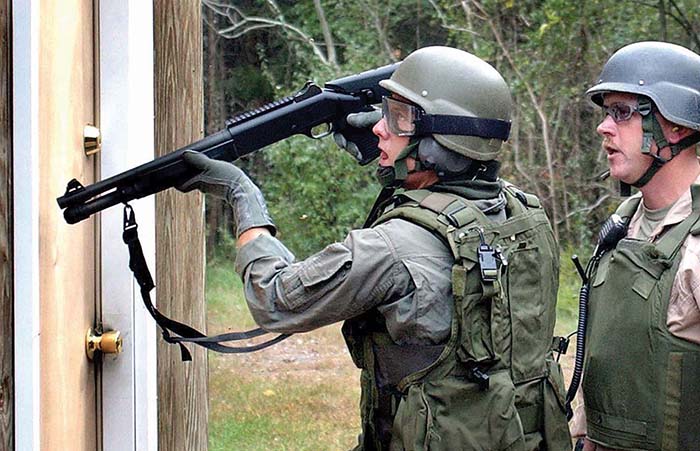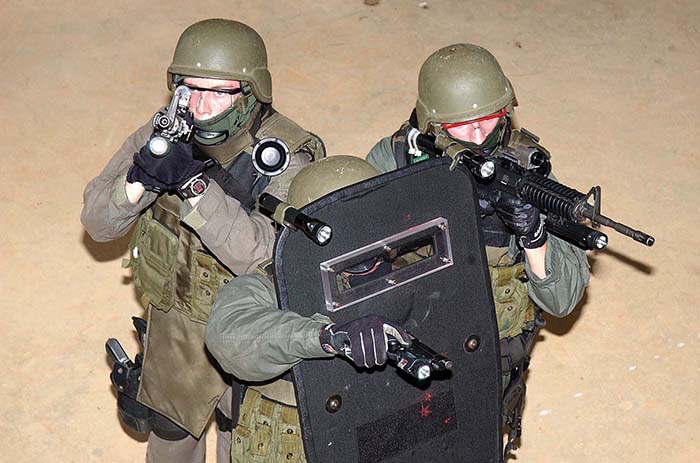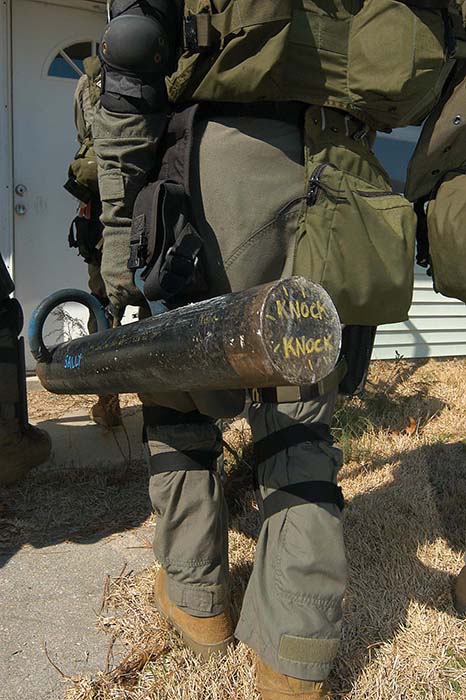By Robert Bruce
Above: 5 March 2002, Camp Lejune, NC. Led by the shield man, SRT Marines rush in stack formation from the shelter of their tactical van. A close look at the men provides a wealth of knowledge on their specialized assault gear. Note ballistic leg guards on the shield man who, along with his backup, has an M9 pistol equipped with the new AN/PEQ-6 infrared and visible aiming light. The last two men in the stack have 9mm MP5 submachine guns sporting tactical lights, as well as holstered M9s. (USMC photo by Corporal Zachary Crawford)
“Although one of many, several things make Quantico’s SRT unique in The Corps: We’re one of a handful of full time teams; we conduct daily Anti-Terrorism missions that include boat and all-terrain vehicle patrols; and we support daily Military police operations to include conducting numerous security missions for VIPs in the National Capitol Region.” Staff Sergeant Aaron J. Bosch, Marine Corps Base Quantico SRT staff non-commissioned officer-in-charge

(USMC photo by Lance Corporal Brandon Holgersen)
“Gas! Gas! Gas!”
The shouted warning cut through sharp bursts of submachine gun fire from the six Marines on line. But only half of the men stopped shooting to pull on their protective masks. The rest kept pumping short strings of 9mm slugs into the silhouette targets until their masked partners resumed firing. Only then did they release their weapons – securely tethered to tactical slings – and reach for their own masks.
This radical departure from regular Marine Corps tactical doctrine is one dramatic difference to be seen in Special Reaction Team (SRT) training, explained Staff Sergeant Aaron Bosch, staff non-commissioned officer-in-charge of Quantico’s elite unit, overseeing recent M9 pistol and MP5 submachine gun training on a remote range.
“You don’t want to lose fire superiority in a close engagement by having everybody stop and mask at once,” Bosh told his men prior to the drill. “Your partner has gotta hold his breath and keep shooting so get that mask on fast!”

Because SRTs must be ready to deal with the full spectrum of chemical and biological hazards ranging from ordinary tear gas to nerve agents and even anthrax spores, rapid donning and extended wear of their sophisticated MALB masks are a regular part of training exercises.
While its wide, clear visor gives an excellent field of view, says Sergeant Nathan Carithers, Team Leader, the mask increases the degree of difficulty for the men in a number of ways including the precise aiming of their weapons. It also muffles the shouted commands and responses that are so necessary for team operations and restricts deep breathing when rushing around in heavy body armor and gear. “But, that’s all part of the job,” Carithers says. “We train this way now so we’ll know how to deal with it when the real thing comes up.”
Training for the Unusual
While successful completion of the Army-run basic Special Reaction Team course at Fort Leonard Wood’s Military Police School is an entry-level requirement for these elite MPs from all the US Armed Forces, Marine Corps SRTs also conduct their own specialized on-the-job training. Teams intensively operate together in a variety of situations such as room clearing drills to build trust and teamwork. Individual skills such as small arms proficiency are regularly sharpened and then put to work in multiple engagement scenarios with lots of variables. Cross-training is essential so that every member will be able to take up the job from someone who goes down in action.
Seasoned members are afforded some exciting advanced training opportunities so that teams will have both enhanced capabilities and expertise to conduct their own classes for new team members. Among many on the long menu are Dynamic Entry and Explosives Breaching, Scout Sniper, Helicopter Rope Suspension, Advanced Close Quarters Battle, Water Survival, and Hand-to-Hand Combat Instructor.

Working with other SRTs in the Corps, other services, local and federal government, also provides great advantages. Quantico’s MOUT (Military Operations on Urban Terrain) combat town attracts a variety of teams including the Pentagon Police. There is also the unique situation of having the FBI Academy right on base.
“It’s been great to be able to train with the FBI’s Washington Field Office S.W.A.T. (Special Weapons and Tactics) team,” Bosch says, “and also to use the Academy’s shoot house for live fire.”
Balance of Power
Quantico’s SRT has some significant upgrades that will be in place by the time this is published. One of these areas is in tactical communications for voice and data in various modes including secure integration of cell phones with real-time radio.
Guns ‘n Gear of the Marine SRT
The US military’s standard sidearm is the M9, a 9mm Beretta 92F semiautomatic pistol weighing just over 2 pounds and featuring a generous 15-round magazine. A slightly modified version, featuring an underbarrel hardmount for tactical lights, is issued to Marine SRTs, typically carried in Safariland 6004 series drop leg holsters. While the sophisticated AN/PEQ-6 is available when both infrared and white light is needed for aiming, Quantico’s SRT usually employs the sturdy and bright Streamlight M3.
Because the DoD mandated 9mm ball round is not an ideal man-stopper, multiple hits are mandatory. This makes the fast firing Heckler & Koch MP5 submachine gun an essential tool for putting ‘em down hard and fast. The legendary reliability and demonstrated accuracy of these long serving law enforcement workhorses speaks well for their continued use by Marine SRTs who appreciate the weapon’s compact dimensions and controllability. 30-round stick magazines provide plenty of ammo between reloads and HK’s optional tactical sling and forearm with integrated white light are in use by the Quantico team.
The 5.56mm Colt M4A1 Carbine is in the pipeline for issue and will give designated team members the ability to penetrate such things as masonry walls and body armor that the 9mm can’t. Originally developed for Special Operations Forces, this short barrel, telescoping stock version of the M16A4 service rifle has a lot of hard points on the top and around the forearm for attachment of various accessories. The SRT version is expected to come with the Trijicon Reflex illuminated dot sight in SOF version with its distinctive polarizing filter and dust cover, vertical foregrip and tactical light.
A specific Marine Corps requirement resulted in fielding of the M1014 semiautomatic shotgun, a modified Benelli with telescoping stock and high capacity tubular underbarrel magazine. This versatile weapon is used with different loads by Marine SRTs for a number of practical tasks including energetic punchdowns and breaching locked doors.

Precision shooting by the SRT’s marksman/observers on cover teams is usually done with the Marine Corps’ Designated Marksman Rifle, a customized M14 semiautomatic, or a bolt operated weapon. Two of the most common of these are the Marine M40 series or the Army M24, both equipped with powerful scopes and capable of remarkable accuracy at extreme range.

(USMC photo by Corporal Ryan Walker)
When the need arises for stealthy night observation and shooting, the teams can break out the usual GI darktime hardware including AN/PVS-7B goggles and the PVS-10 integrated day/night scope.
Most teams have an intentionally ordinary-looking commercial white box van to haul all their equipment around, jam-packed with all sorts of interesting tools. Quantico’s SRT van is typical, and we’re told it is home for the team’s primary and secondary weapons, shields and ballistic blankets, tactical radios, breaching tools, and night vision gear.
Because MCB Quantico is cut in half by heavily-traveled major highways and also has an enormous perimeter that includes extensive frontage along the Potomac River as well as a spider web of rural roads out in the sprawling range complex, there are two other very interesting vehicles in the team’s inventory. They have recently put into service a brand new 23-foot patrol craft from Aluminum Chambered Boats for daily runs over water and a Polaris Ranger 4×4 all terrain vehicle to get around handily through the woods.
Becoming an SRT Marine
Because every major Marine Corps installation in the US and abroad has a Special Reaction Team, there are many opportunities for those who would like to join this elite brotherhood.
Obviously, the first step is to enlist in the United States Marine Corps as a Military Policeman, MOS 5811. Call your hometown recruiter (look in the phone book’s blue government pages) or visit the internet site www.usmc.mil. Following successful completion of Boot Camp and Military Police School, perform your duties with dedication and skill. If you are assigned to an installation with an SRT, talk with the team’s leadership about your intentions then follow this up with any necessary paperwork.

(USMC photo by Corporal Zachary Crawford)
Rules and requirements for selection of SRT members vary with each installation but here are some general guidelines for volunteers:
- Hold Military Occupational Specialty 5811, Military Policeman, with at least one year of operational experience and minimum rank of Corporal.
- Demonstrate a high degree of maturity and self-control.
- Meet height/weight standards and achieve First Class on Physical Fitness Test.
- Qualify Expert with rifle and pistol.
- Have a clean record.
- Be available for fast response 24/7.

(USMC photo by Corporal Ryan Walker)


(USMC photo by Corporal Wil Acosta)
Additionally, all volunteers considered for selection to SRTs are psychologically screened before assuming their duties.
| This article first appeared in Small Arms Review V9N2 (November 2005) |











